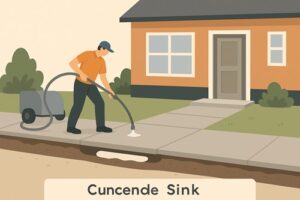
Ever noticed a sunken slab in a driveway or a walkway that feels more like an obstacle course? That’s more than just an eyesore. Uneven concrete can be a red flag for deeper issues and, if left untreated, can lead to serious damage to your property.
Concrete lifting, sometimes called slab jacking or concrete levelling, is a smart solution to these problems. It’s not just about making things look nice. It’s about protecting the structure and value of your home or commercial property.
Why Concrete Starts to Sink
Concrete is tough, no doubt about it. But it’s not immune to the forces of nature. Over time, the ground beneath concrete slabs can shift, settle or wash away. Here’s why that happens:
- Soil erosion – Water runoff, especially from poor drainage, can wash away the soil under your concrete.
- Poor compaction – If the ground wasn’t properly compacted when the slab was first laid, it may start settling unevenly.
- Tree roots – These can push against or lift slabs from underneath, then leave voids when they die or are removed.
- Moisture changes – Expanding and contracting soil due to wet and dry cycles can cause instability under slabs.
When the support under a concrete slab disappears or becomes unstable, the slab has nowhere to go but down. That’s when you start seeing cracks, sloping, or even full-on tripping hazards.
What Happens If You Ignore It?
Letting sunken concrete sit for too long can open the door to far bigger problems, which is why professional concrete lifting and leveling services are so important. A misaligned driveway or footpath is one thing, but if the issue is near your foundation or entry points, the risks go up fast. Water starts pooling in the wrong places. It might creep towards your foundation. That’s how water damage, mould issues, and even structural shifting start.
Inside the home, you might not connect squeaky floors or stuck doors to uneven concrete outside. But often, they’re linked. As concrete shifts, it can affect the alignment of structures built on or near it.
And let’s not forget resale value. When buyers see cracked, sunken concrete, it sends the wrong message. It looks like neglect. Whether that’s fair or not, it matters.
The Role of Concrete Lifting
Concrete lifting works by injecting material beneath the slab to raise it back to its original height. It’s a relatively quick fix compared to tearing the slab out and starting over.
More importantly, it tackles the cause: those empty spaces or loose soils underneath. By filling voids and stabilising the base, it stops further movement and prevents new damage from forming.
There are a few different methods out there, but the goal is the same: restore level, support the slab, and protect surrounding structures.
Key Areas Where It Makes a Difference
Concrete lifting isn’t just for driveways. It’s used in a variety of spots around homes and properties. Each one comes with its own set of risks if ignored.
Driveways and Garages
Sunken areas here can collect water. That water might then flow towards your garage or seep into your foundation. Not only does this risk water damage, but the pooling can wear away at surfaces, making the problem worse over time.
Walkways and Entries
This is where safety comes into play. Uneven paths are a trip hazard, plain and simple. If someone gets hurt, that opens up legal and financial risk, especially for commercial properties.
Patios and Outdoor Areas
While aesthetics are more noticeable here, the structural impact still matters. An uneven slab might pull away from the house, leave gaps where water can enter, or start cracking and breaking apart.
Foundations and Slab Floors
This is the big one. Sinking in or around the foundation can cause wall cracks, uneven floors, and misaligned doors or windows. Addressing it early with lifting can save thousands in future repairs.
What Makes Lifting Better Than Replacement?
Tearing up concrete and starting from scratch sounds like a solid solution, but it’s usually overkill unless the slab is severely damaged. Here’s why lifting is often the better option:
- Less invasive – No heavy demolition or days of downtime.
- Faster – Most jobs can be completed in a matter of hours.
- Cost-effective – It generally costs much less than full replacement.
- Environmentally friendlier – It reuses existing materials instead of sending them to landfill.
Most importantly, it directly addresses the cause. Replacement looks fresh, but if you don’t fix the ground beneath, it’ll just sink again eventually.
Protecting What You’ve Built
Whether it’s a family home or a commercial property, the structures we live and work in are only as strong as their foundations and the concrete that supports them. Lifting a sinking slab isn’t just a patch job. It’s a smart, preventative step that helps avoid bigger problems down the road.
It’s the kind of fix that gives peace of mind, knowing you’re not just reacting to damage but actively protecting against it. And that’s always worth it.




Leave a Reply